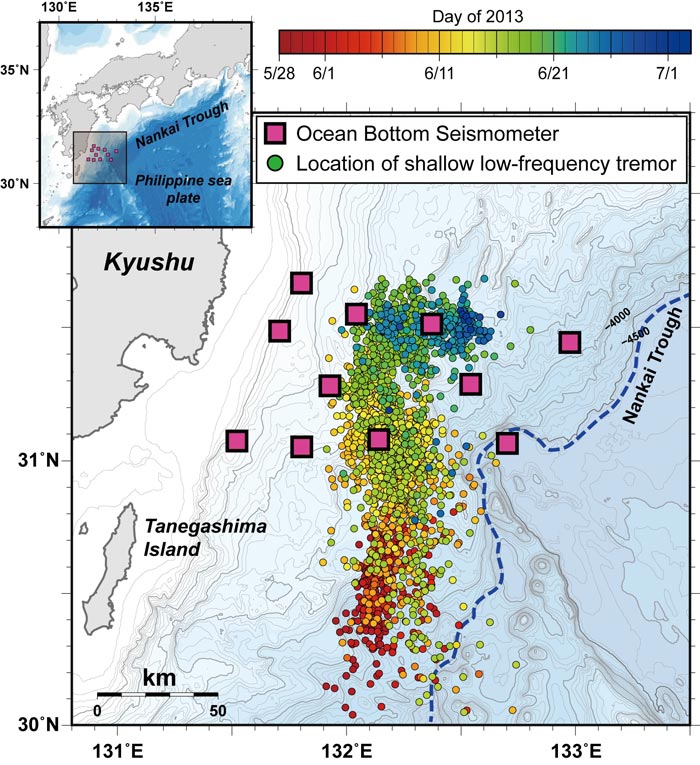Migrating low-frequency tremors observed at shallow subduction interface

Distribution of shallow low-frequency tremors detected by the ocean bottom seismometer network. Yellow squares show the locations of ocean bottom seismometers. Circles indicate the distribution of occurrence of shallow low-frequency tremors, while the color of the circle indicates the time of occurrence. © 2015 Yusuke Yamashita.
A University of Tokyo research group has discovered slow-moving low-frequency tremors which occur at the shallow subduction plate boundary in Hyuga-nada, off east Kyushu. This indicates the possibility that the plate boundary in the vicinity of the Nankai Trough is slipping episodically and slowly (over days or weeks) without inducing a strong seismic wave.
It was thought that the shallow part of the plate boundary was completely “uncoupled,” being able to slowly slip relative to the neighboring plate. However, after the 2011 Great East Japan Earthquake, it was discovered that is not entirely correct, and it is very important, in particular in the Nankai Trough, an area in which a major earthquake is expected, to understand the coupling state of the plate boundary.
Hyuga-nada is located off east Kyushu in the western part of the Nankai Trough, a highly seismically active area in which M7-class interplate earthquakes occur every few decades, but interplate slip at the shallow plate boundary in this region is insufficiently understood.
A research group comprising Project Researcher Yusuke Yamashita, Assistant Professor Tomoaki Yamada, Professor Masanao Shinohara and Professor Kazushige Obara at the University of Tokyo Earthquake Research Institute and researchers at Kyushu University, Kagoshima University, Nagasaki University, and the National Research Institute for Earth Science and Disaster Prevention, carried out ocean bottom seismological observation using 12 ocean bottom seismometers installed on the seafloor of Hyuga-nada from April to July 2013.
The research group discovered migrating (moving) shallow low-frequency tremors which are thought to be triggered by slow episodic slipping (slow slip event) at the shallow plate boundary. The shallow tremors had similar migration properties to deep low-frequency tremors that occur at the deep subducting plate interface, and that they also occurred synchronized in time and space with shallow very-low-frequency tremors that also thought to be triggered by slow slip events.
These observations indicate that episodic slow slip events are probably occurring at the shallow plate boundary in the vicinity of the Nankai Trough.
After the 2011 Great East Japan Earthquake, a fundamental review of the shallow plate boundary interface is required. These new findings provide important insight into slip behavior at a shallow plate boundary and will improve understanding and modeling of subduction megathrust earthquakes and tsunamis in the future.
This research was published in the American journal Science on May 8, 2015.
Paper
Yusuke Yamashita, Hiroshi Yakiwara, Youichi Asano, Hiroshi Shimizu, Kazunari Uchida, Shuichiro Hirano, Kodo Umakoshi, Hiroki Miyamachi, Manami Nakamoto, Miyo Fukui, Megumi Kamizono, Hisao Kanehara, Tomoaki Yamada, Masanao Shinohara, Kazushige Obara, “Migrating tremor off southern Kyushu as evidence for slow slip of a shallow subduction interface”, Science Vol. 348 no. 6235 pp. 676-679, doi: 10.1126/science.aaa4242.
Associated links
U Tokyo Research article
Media Contact
All latest news from the category: Earth Sciences
Earth Sciences (also referred to as Geosciences), which deals with basic issues surrounding our planet, plays a vital role in the area of energy and raw materials supply.
Earth Sciences comprises subjects such as geology, geography, geological informatics, paleontology, mineralogy, petrography, crystallography, geophysics, geodesy, glaciology, cartography, photogrammetry, meteorology and seismology, early-warning systems, earthquake research and polar research.
Newest articles

NASA: Mystery of life’s handedness deepens
The mystery of why life uses molecules with specific orientations has deepened with a NASA-funded discovery that RNA — a key molecule thought to have potentially held the instructions for…

What are the effects of historic lithium mining on water quality?
Study reveals low levels of common contaminants but high levels of other elements in waters associated with an abandoned lithium mine. Lithium ore and mining waste from a historic lithium…

Quantum-inspired design boosts efficiency of heat-to-electricity conversion
Rice engineers take unconventional route to improving thermophotovoltaic systems. Researchers at Rice University have found a new way to improve a key element of thermophotovoltaic (TPV) systems, which convert heat…



